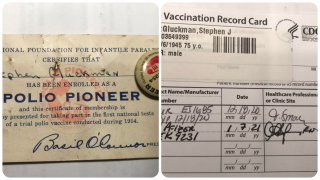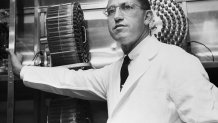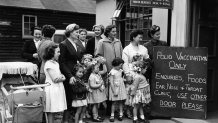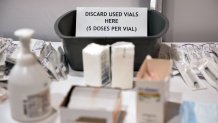
Dr. Stephen Gluckman is holding onto two pieces of vaccine history.
One, from the 1950s, labels him a "Polio Pioneer." He was one of the million-plus children around the country who took part in the clinical trial for Jonas Salk's polio vaccine.
Another shows that Gluckman, a Penn Medicine physician, received his second shot of the Pfizer-BioNTech vaccine early this month, decades after he participated in Salk's trial.
He thought about the past a few times as he lined up for those doses. In some ways, it was the same: another mass vaccination efforts in which he got multiple shots. But his parents might have been more scared of polio than he was at the time.
Get top local stories in Southern California delivered to you every morning. Sign up for NBC LA's News Headlines newsletter.
Now, he's scared.
"The major difference is my fear and concern about COVID, it’s a real disease, with a real significant impact," Gluckman, 75, said. "The medical component, which is what I mostly deal with, is important ... but the implications beyond the medical component are massive. People losing jobs, businesses, the effects on schools and education."
As the nation rolls out the Pfizer and Moderna vaccines, those with more considerable life experience are among the first in line to receive it. And they're recalling a previous mass vaccination effort from their youth: summers when hardly any of them swam in the pool, as their parents were terrified of their children facing the devastating effects of poliomyelitis.
Back then
The disease believed to have caused Franklin Delano Roosevelt's paralysis spread through contaminated food or water. If someone infected with polio shows symptoms, they most commonly have a fever, pain and vomiting. A small percentage of cases spread to the central nervous system, leading to paralysis or death. If polio weakened a patient's ability to breathe, they could be placed in an iron lung, a type of respirator not often seen today.
Pittsburgh-area researcher Dr. Jonas Salk developed a cure that would soon be tested in perhaps the largest medical product test in the nation's history. Thanks to funding from the charity the March of Dimes, more than a million schoolchildren took part in a huge clinical trial.
The vaccinators came to Gluckman's elementary school when he was in second grade. He remembers lining up outside the school nurse's office.
"Everybody was scared because we knew it involved needles. And we marched in there one at a time, so nobody else could hear people crying, if they were," Gluckman said.

He got his three shots spread out in that school year. Children received blood tests to check for immunity, and it took a year to collate and analyze the data from so many different local sources.
Then came a news conference, where Dr. Thomas Francis announced the Salk vaccine was "safe, potent and effective," to the relief of millions of frightened parents.
"Those three words were the headline of every newspaper in America," said Dr. Paul Offit, who heads the Vaccine Education Center at the Children's Hospital of Philadelphia.
Offit says the polio vaccination effort was "Warp Speed One." Doses were being manufactured before the trial was complete, allowing for larger supply than if manufacturers had waited for the trials and approvals to finish.
As luck would have it, Gluckman received the placebo as part of the study, and would have to go back for three shots of tried-and-tested vaccine. Though he might have felt unlucky, many felt joy.
"I think it has to be looked at in the context of how Americans thought of science at that time," March of Dimes archivist David Rose says in a video in The History of Vaccines, a project by The College of Physicians of Philadelphia. "It was the tail end of the McCarthy era, there was the Cold War paranoia, there was the fear of the atomic bomb, and here [Salk] was a hero, a real scientific hero that I think many Americans, ordinary Americans, could connect with. Because if nuclear war was feared during that time, polio was also highly feared, and here was the beginning of the end of that dreaded disease."
After the trials were complete, the March of Dimes and counties in our region established clinics for children to get vaccinated. In the 1950s and '60s, Bucks County's health department had Well Child Clinics at schools, churches, an American Legion hall and a Quaker meeting house.
All these years later, the Mercer Museum in Doylestown holds the personal papers of Bernice M. Gorski, a nurse who worked in the clinics and administered polio shots. One letter from the health department asks her to work a monthly slate of clinics for $2.50 an hour.
There was also a considerable public health messaging effort encouraging parents to get their children vaccinated. The messaging needed to overcome some parents' skepticism after a batch of defective doses from Cutter Labs in California killed 10 children and infected tens of thousands (which Offit chronicled in a book).
Bucks County in May 1956 released a pamphlet calling the polio clinics "the best chance for protection before polio hits again, if vaccine is given now" to children six months to 14 years old, and to expectant mothers.
"As the supply of Salk vaccine increases, these as well as older children may be able to receive it through their family doctors," the pamphlet reads. It called for an immediate step up in vaccinations to "make a real dent in polio in 1956."
By mid-June of that year, more than half of the county's 42,000 children 14 and under had received at least one shot.

Gorski later received a handwritten letter of recognition from Sisters of the Immaculate Heart of Mary, thanking her for possessing the healing skills of the "Great Physician," a reference to Jesus Christ.
"That innate understanding has very often brought solace to those in pain and fear, especially timid school children," the Sisters wrote.
A few years after Salk's vaccine was approved, it became less common when Albert Sabin's vaccine was also shown to be effective in clinical trials. A dose of the Sabin vaccine could be put on a sugar cube with a dropper and it didn't require a professional to simply hand the cube to a child.
Philadelphia's Health Commissioner, Dr. Thomas Farley, recalled his childhood experience getting that vaccine during a city news conference about the current pandemic.
"Everybody just lined up. You walked in, they handed you a sugar cube, you swallowed it and walked on. Each person was a few seconds," Farley said.
Today's new challenges
While it was a Herculean effort to study more than a million children involved in the Salk trial, and then roll out to the nation's children, vaccination efforts against polio had their advantages compared to today's rollout of the coronavirus vaccine.
For one, Offit says, vaccinators knew exactly where to go for their target population: schools.
"They were a confined group. You could go to schools and know that you had children there."
America's 250-260 million adults make up a larger chunk of society, and adults are spread all over, making it more difficult to meet them where they are.
"We’re inoculating at the Pennsylvania Convention Center, we’re inoculating at Dodger Stadium, because we’re just trying to find ways to create an infrastructure that doesn’t exist, which is an infrastructure for mass vaccination. It was easier then, cause you had a catchment," Offit said.

In city news conferences, Farley has said administering the Pfizer and Moderna shots so far has been less simple than when he got the Sabin vaccine in school.
"People have to wait 15 minutes to make sure they don’t have an allergic reaction, and we don’t want to just give it to anybody. We have set priority groups that are based on how we can maximize the number of lives we save. And so that makes it more complicated," Farley said.
Local public health officials have already made statements and are planning public information campaigns encouraging residents to get vaccinated against the coronavirus.
There has been no Cutter Labs-magnitude incident to address, but officials will have to combat fears fueled by social media misinformation. They'll likely highlight the huge 95% effectiveness rate from clinical trials, the fact that the Pfizer and Moderna shots contain no actual virus, just genetic material, and stress that while they've received widespread media coverage, dangerous allergic reactions are rare. The shots offer protection against a disease that has killed hundreds of thousands of Americans and left many who survived with lasting health issues.
The coronavirus pandemic "is just like polio was, just like World War II was, it's a shared national tragedy," Offit said. "But it's not perceived that way. ... I think the Trump administration did everything they could to ask you to participate in a cult of denialism that this is all going to go away, if we just shut our eyes tight enough."
But he's confident the nation has what it takes to mass vaccinate the population, and one day beat the virus.
Gluckman said thanks to the success of science and vaccinations, polio only circulates in landlocked, remote parts of central Asia now.
“I don’t want to trivialize the fact that some people can still get the disease," Gluckman said. "But for practical purposes, it’s gone. And there hasn’t been a case in this hemisphere in decades. It’s a triumph, a scientific triumph."

